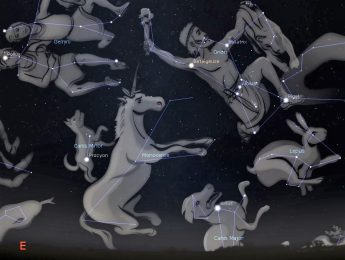This Week’s Sky at a Glance, 2024 Jan. 6 – Jan. 13
This Week’s Sky at a Glance, 2024 Jan. 6 – Jan. 13
With Orion’s hourglass figure now above the horizon after sunset, the giant hunter waits an hour or so for his two dogs to get up before he starts hunting. The first to greet the night is Canis Minor the Little Dog, a small constellation highlighted by Procyon, the eighth brightest star. To identify this star, Orion’s head and shoulders form an arrowhead, with orange Betelgeuse at the apex, which points toward Procyon. Like Sirius in Canis Major, this star is bright because it is in our celestial backyard, about 11 light years away.
The name Procyon means “before the dog,” indicating it is a harbinger of Sirius the Dog Star which rises about 40 minutes later. Ancient Egyptian farmers watched for the first visible rising of Sirius before sunrise, as experience had taught them the Nile would soon flood its banks with fertile soil when this occurred. In mythology the two dogs are sometimes depicted as Laelaps (Canis Major), an extremely fast dog, and an equally fast fox (Canis Minor). The dog was sent to hunt the fox but, after a long chase with no apparent end, Zeus turned them both to stone and placed them in the sky.
I like to look at the dogs and their westerly neighbours, Orion the Hunter and Lepus the Hare, in a more modern sense. The mighty demigod Orion becomes everyone’s favourite hunter, Elmer Fudd, with that wascawwy wabbit bugging him below his feet. The big and little dogs become Spike and Chester, who were also part of the Looney Tunes gang. Just as Chester would bounce around in front of his hero, the bulldog Spike, Canis Minor bounces up before Canis Major.
This Week in the Solar System
Saturday’s sunrise in Moncton is at 8:01 and sunset will occur at 4:48, giving 8 hours, 47 minutes of daylight (8:03 and 4:56 in Saint John). Next Saturday the Sun will rise at 7:58 and set at 4:57, giving 8 hours, 59 minutes of daylight (8:01 and 17:04 in Saint John).
Look to the southeast after 7 am Monday to see the crescent Moon approaching Antares, with Venus to their upper left and Mercury about 15 degrees to the lower left. Telescope users might be able to catch the Moon occult Antares roughly between 11:02 and 11:55. The Moon is new on Thursday. Saturn sets around 8:40 pm midweek so observe it early. This Saturday telescope users might catch a double shadow transit of Jupiter’s moons Ganymede and Europa between 10:20 and 10:55pm, and the Red Spot around 7 pm Sunday and 8:30 on Tuesday. Mercury is at greatest elongation Friday, rising 100 minutes before sunrise and leading Mars by 45 minutes.
The Saint John Astronomy Club meets in the Rockwood Park Interpretation Centre this Saturday at 7 pm, and the Fredericton Astronomy Club meets in the UNB Forestry-Earth Sciences building on Tuesday at 7 pm. On Sunday evening at 8 pm, tune in to the Sunday Night Astronomy Show via the Facebook page or YouTube channel of Astronomy by the Bay.

